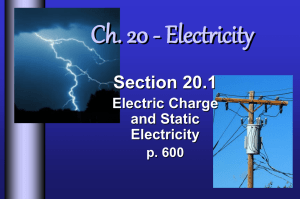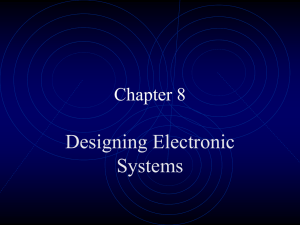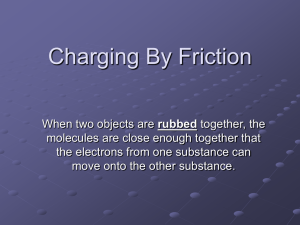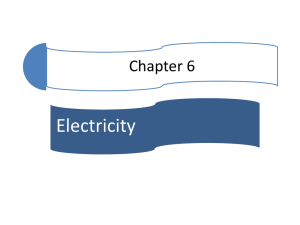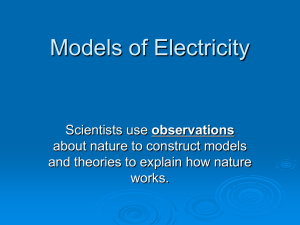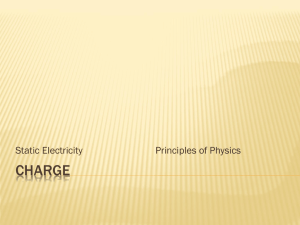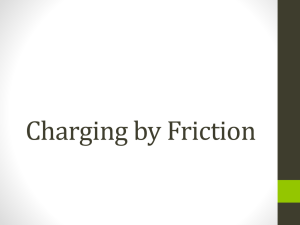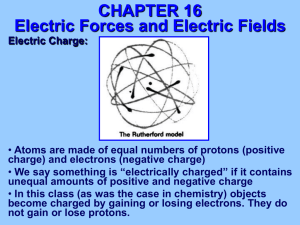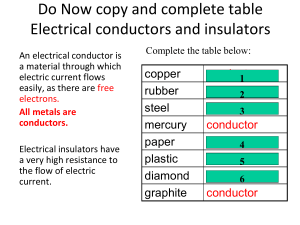Static Electricity
advertisement
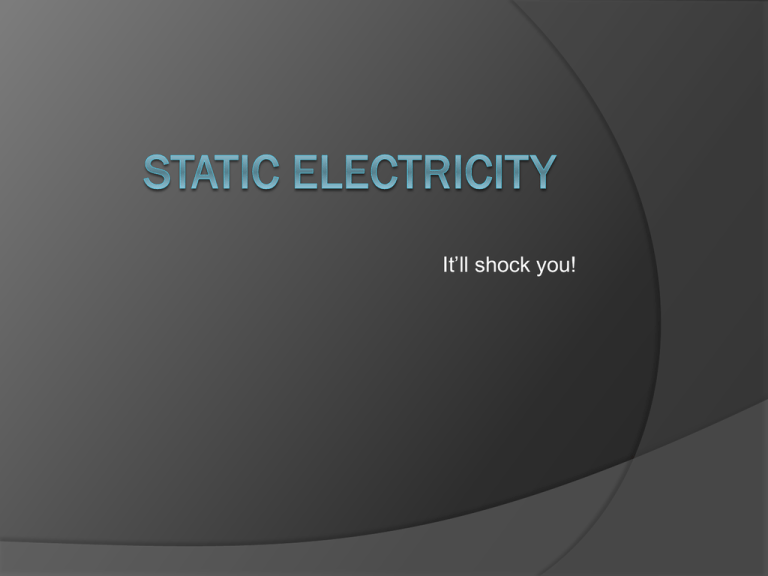
It’ll shock you! What is Electricity? The movement of charges (electrons) Can be passed (current) or Stationary (static) Electrostatics= the study of static electricity Differences? Static Electricity: charges build up on the surface of an object Flow of charges last for very short periods of time Unpredictability makes it difficult to use Current Electricity: Charges flow through a conductor in a controlled way Flow is steady and follows a predictable path Electricity: The Facts All objects are neutral until they are charged to become positive or negative If an object gains electrons (-) and possesses more electrons (-) than protons (+), it has an overall NEGATIVE charge If an object loses electrons (-) and possesses more protons (+) than electrons (-), it has an overall POSITIVE charge *An atom cannot GAIN protons to become positive Trapped in the nucleus and do not move Law of Electrostatic Attraction 1) Opposite Charges attract each other Ex. North/South ends on a magnet 2) Same / Like charges repel each other Ex. Positively charged hairs 3) Charged objects (+ or -) can attract some neutral objects Electrostatic Series A chart designed to indicate the likelihood of an object to gain or lose electrons Materials like Acetate, Wool and hair are more likely to lose electrons and become positive Materials like carbon, rubber and gold are more likely to pick up electrons Acetate Glass Wool Cat’s/Human hair Ca, Mg, Pb Silk Al Zn Cotton Ebonite Polyethylene C, Cu, Rubber Sulfur Pt, Au Charging Objects Charging by Contact A. B. Charging by friction Charging by conduction Charging by Induction *Accompany each of the following slides with an electroscope diagram Friction Rubbing two objects together, transferring electrons from one object to the other (creating a charge imbalance) Classic Examples: Hair (+) and Rubber Balloon (-) Socks (+) on a carpet (-) Door knob (conductor) Static cling in the dryer fabric softener increases moisture to reduce static cling Conduction Once contacted, electrons transfer from negative object to positive object to balance out (minimize) the charge imbalance Neutral Charged Induction Electrons move to one part of an object because it is in the electric force field of another * Object altered does not touch the charged object An object does not have to become completely positive or negative Grounding Symbol to indicate Connecting an object to a large body, like Earth, that is capable of effectively removing an electric charge that an object might have Ex. A tap (see text book pg. 475 Two metal stands are mounted on insulating stands (grounded) II. Presence of – charge induces e- to move from sphere AB III. Sphere B is separated from A (contacting insulated stand) I. Sphere A & B are now opposite charges I. Comparing the Three Using the example of rubbing your feet on a carpet and touching a door knob, let’s compare the three methods of charging Friction: rubbing feet on the carpet gives your socks a – charged and the floor + charge Conduction: Your foot has become charged by friction and therefore, your body has as well since they are connected (contact) Induction: Electrons in your fingers tips brought close to the door knob repel the –’s, making the knob + Static Discharge Objects do not like to become charged Neutralization of build-up of charge is known as a discharge Once a build-up has been discharged, the objects return to a neutral state A discharge is often visible and its size depends on the build up Shock on a door knob Lightning Lightning Lightning is a natural process of the Earth and the atmosphere exchanging electric charges Thunder cloud and ground are both neutral at first Particles in the cloud separate (+ Top, - Bottom) + in ground are now closest to cloud and – are repelled downward Charge build up causes a discharge (will strike the tallest object) Conductors Anything that allows electrons to move on or through it freely Most metals are great conductors Copper is the best example of a conductor as it has one valence electron that is easily shared conducts the electricity When considering air, the higher the moisture, the more conductive. Reducing the moisture creates a dry, insulated environment and the build up of static electricity Examples of Conductors Most turquoise elements Insulators Do the opposite of conductors do not allow electrons to flow/move easily Electrons are tightly bound together which prevents the flow of charges Insulators are used to help protect us from the harmful effects of electricity Ex. rubber case around copper wires (allows electricity to flow along the wire but you can touch the wire casing and not feel a shock Examples of Insulators Helps to keep your car grounded Lightning Rods Used to direct the flow of electrons away from buildings Charged by induction (positive charges) Attracts – ions that form in the air providing a path for the lightning Electrons are carried around the building and into the ground by a heavy conductor Electrostatic Precipitator Used to remove 99.9% of solid and liquid contaminants from exhaust air (smoke stacks) Harmful exhausts enter into a large grounded cylinder Central conductor in the cylinder is highly charged, the same charge as the particles in the exhaust Exhaust is repelled toward outer cylinder and once they collide, they discharge and collect into liquid/solid that can be removed Electrostatic Spray Paint Object being painted is given a + charge (by contact) Paint particles become – charged as they pass through the nozzle of the spray gun Helps to prevent paint waste Faster more efficient Creates smoother finish/ even surface coat Antistatic Dryer Sheets (Bounce) Used to prevent clothes from clinging to each other Heat releases the wax on the dryer sheet which in turn, coats the clothes or fabric with a waxy lubricant When clothes tumble, static charges cannot build up since the surface of the clothes is the same Static in the Winter Static electricity increases in the winter time because everything is so much more dry Less moisture/ humidity in the air, the more insulating the air becomes which is likely to hold a charge and cause a build up rather than travel through the air Ex. The Summer Balloon Experiment Quiz Time! Thursday, April 25th Everything in this slideshow Terminology (Electricity, Static Electricity, Conductor, Insulator, etc.) Laws of Attraction and Repulsion (and applying them) Identifying Charges Charging Objects by Friction/Conduction/ Induction Look ahead to Current Electricity The flow of electrons along a conductor You’ll see words like: Series Parallel Load Energy source Ampere Ohm Potential Difference Electrical Resistance [and so on]

